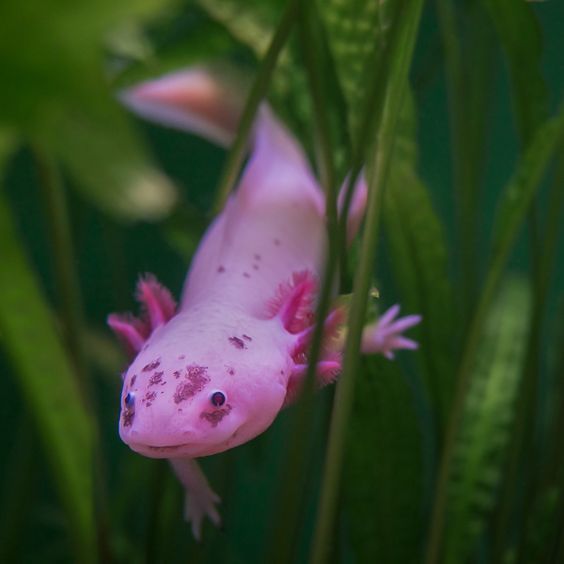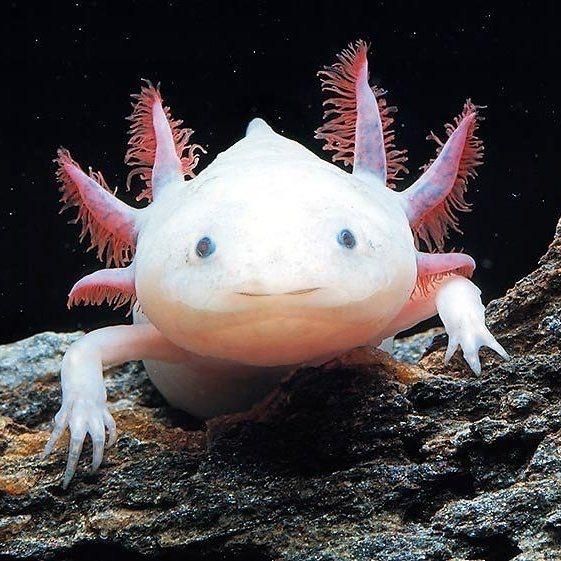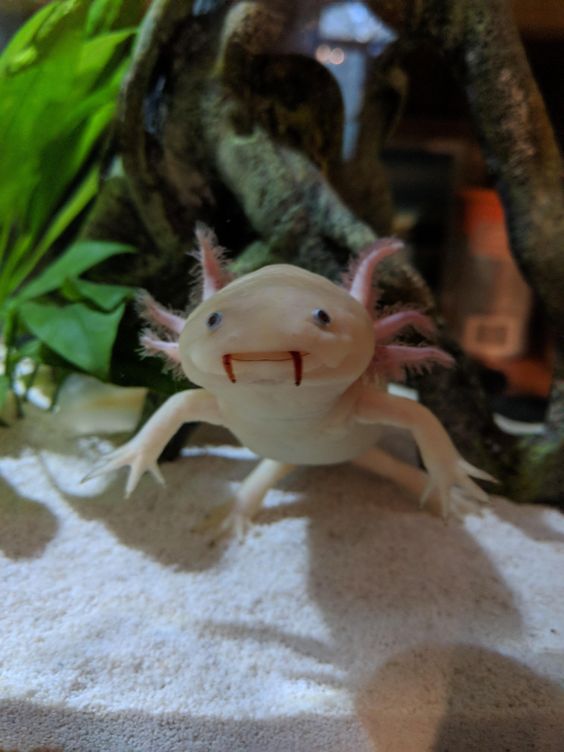
Axolotls are fascinating creatures, often referred to as “Mexican walking fish” or “water monsters.” These amphibians are known for their regenerative abilities and unique appearance. One common question that prospective axolotl owners often ask is, “Are axolotls aggressive?” In this article, we will explore the various aspects of axolotl behavior to shed light on their aggression tendencies.
Reasons that Make Axolotls Aggressive
Axolotls, those enigmatic aquatic beings, can sometimes surprise their owners with displays of aggression. To understand this behavior better, we must delve into the reasons that make axolotls aggressive.
First and foremost, habitat conditions play a pivotal role. Axolotls are highly sensitive to water quality. Poor water conditions, such as high ammonia or nitrite levels, can stress them out, leading to aggression. Therefore, maintaining pristine tank conditions with efficient filtration and regular water changes is essential to prevent such aggressive outbursts.
Furthermore, axolotls can exhibit territorial behavior. In the wild, they have their own territories and do not take kindly to intruders. When confined to a limited space in captivity, they may become territorial if they perceive a threat from other axolotls. Providing ample tank space and hiding spots can mitigate territorial disputes among them.
What Are the Factors That Influence Axolotl Aggression?
Axolotls, like many creatures, can be territorial by nature. In their natural habitat, they establish their own domains, and this behavior can carry over into captivity. Limited space or the presence of other axolotls can trigger territorial disputes. To minimize such conflicts, ensuring that each axolotl has sufficient space and hiding places in the tank is crucial.
Another factor that influences axolotl aggression is sexual dimorphism. Male axolotls, in particular, tend to be more aggressive, especially during the breeding season. When kept in close quarters, these males may vie for dominance, leading to aggressive encounters. For this reason, it is often recommended to keep male and female axolotls separate unless breeding is intended. Additionally, environmental stressors and overcrowding can impact their behavior. Understanding these factors is crucial when caring for axolotls, particularly unique variants like black melanoid axolotl.
Do Axolotls Exhibit Cannibalistic Behavior?
Yes, axolotls are known to exhibit cannibalistic behavior under certain circumstances. This behavior is often triggered by hunger or stress. In crowded tanks or when they are not adequately fed, axolotls may resort to eating smaller tank mates, including juvenile axolotls or other small aquatic creatures.
To prevent cannibalism, it is essential to ensure that your axolotls are well-fed and provided with a balanced diet. Monitoring their behavior and offering enough food can reduce the chances of them resorting to cannibalism. Additionally, providing hiding spots and separate enclosures for smaller axolotls can help protect them from potential aggression.
Are Axolotls Aggressive to Humans?
Axolotls, often affectionately referred to as “Mexican walking fish,” possess a unique and gentle disposition. They are not typically aggressive toward humans. In fact, axolotls are renowned for their calm and curious nature, making them a popular choice as aquatic pets.
These amphibians are primarily carnivorous, and their aggression is primarily directed toward small prey items like aquatic insects and small fish. When it comes to humans, axolotls may exhibit inquisitive behavior, often approaching the glass of their tank when their owners approach. This curiosity is not a sign of aggression but rather an expression of their natural interest in their surroundings.
Can Axolotls Harm Humans?
Axolotls are not known for harming humans. While they do have a mouthful of small, sharp teeth, their bite is typically harmless to humans due to their small size and gentle temperament. In most cases, any contact with a human hand would be more exploratory than aggressive.
However, it’s important to note that handling axolotls should be done with care and gentleness to avoid stressing or injuring them. Rough handling can cause them stress, which may lead to defensive behaviors such as biting or thrashing. Therefore, when interacting with your axolotl, it’s best to use wet hands or a soft container to support and guide them rather than trying to pick them up.
Are Axolotls Aggressive Towards Other Fish?
One of the questions that often arises in the world of aquatics is whether axolotls are aggressive towards other fish. The answer to this question isn’t a simple yes or no, but rather a matter of understanding their natural behaviors and unique characteristics. However, Axolotls, including the captivating lavender axolotl, are generally peaceful and solitary creatures.
Axolotls, known for their quirky appearance and regenerative abilities, are generally not aggressive in the same way that predatory fish might be. However, they have a strong feeding instinct and can be opportunistic hunters. This means that they might view smaller fish or creatures that fit into their mouth as potential prey, especially if they are hungry.
Compatibility with Other Fish Species
To determine compatibility with other fish species, it’s essential to consider the size and behavior of both the axolotl and the potential tank mates. Larger, non-aggressive fish that won’t fit in the axolotl’s mouth are generally better companions. Fish like goldfish, guppies, or even some larger tetras can coexist peacefully with axolotls in a well-maintained and appropriately-sized tank.
However, fast-swimming fish or those known to nip at axolotls’ gills or limbs should be avoided, as they can cause stress and injury. Additionally, it’s essential to ensure that the water parameters and temperature requirements of both species are compatible.
Feeding Habits and Aggression
Feeding time can be a potential source of aggression in axolotl tanks. Axolotls are voracious eaters and may compete for food. To reduce mealtime aggression, consider feeding them separately or using feeding tongs to place food directly in front of each axolotl. This minimizes competition and can lead to a more peaceful mealtime.
It’s also important to provide a varied and well-balanced diet to ensure that your axolotls are satiated. Overfeeding can lead to obesity, which can, in turn, result in health problems and increased aggression. A healthy diet and proper feeding techniques can go a long way in maintaining a peaceful aquatic community.
Understanding axolotl feeding habits is crucial in managing their aggression. In cases of aggression among tank mates, providing ample hiding spots, segregating aggressive individuals, and optimizing water temperature with tools like aquarium chillers for axolotl can help minimize stress and maintain a harmonious environment for these unique aquatic creatures.
Is It Possible to Make Your Axolotl Friendly?

Many axolotl owners wonder whether it’s possible to make these fascinating creatures friendly and interactive. While axolotls are not like traditional pets such as dogs or cats, they can become accustomed to human presence and even display friendly behaviors.
Axolotls are naturally curious, and over time, they can recognize their owners and associate them with food. This recognition is a significant step towards building a friendly relationship with your axolotl. While they may not exhibit the same level of affection as a dog, they can certainly become comfortable with your presence and interactions.
Creating a friendly bond with your axolotl is possible, despite their tendency to appear aloof. Addressing the question “Why Does My Axolotl Stare at Me,” it’s a common behavior that can indicate curiosity. Regular, gentle interactions, consistent feeding, and a well-maintained environment can foster trust and help make your axolotl more friendly and receptive to your presence.
How to Tame Your Axolotl
Taming your axolotl requires patience and consistency. Begin by spending time near the tank regularly, allowing your axolotl to become accustomed to your presence. Gradually, you can start offering them food by hand using feeding tongs. This not only associates you with positive experiences but also reduces the risk of aggressive behaviors during feeding.
Another essential aspect of taming is gentle handling. When you need to handle your axolotl, ensure your hands are wet, and always support their body properly. Rough or aggressive handling can cause stress and negatively impact your efforts to make them friendly.
Socialization and Interaction
While axolotls are not social in the same way that mammals like dogs are, they do benefit from mental stimulation and interaction with their environment. Adding aquatic plants, tunnels, and decorations to their tank can provide opportunities for exploration and engagement.
Occasional interaction with your axolotl can also be enriching. Gently stroking their skin (always with wet hands) or offering a treat can help build trust and familiarity. However, it’s essential to be mindful of their stress levels and avoid overhandling.
FAQs
What should I do if my axolotl shows aggressive behavior towards other axolotls?
If you notice aggression between your axolotls, consider separating them into individual tanks. It’s essential to provide each axolotl with its own space to reduce territorial disputes.
Can I keep axolotls with fish in the same tank?
Axolotls are generally not recommended to be kept with most fish species, as they may view them as prey. However, some larger, non-aggressive fish may coexist peacefully with axolotls.
Are male axolotls more aggressive than females?
Male axolotls can be more territorial and aggressive, especially during the breeding season. It’s crucial to monitor their behavior and provide adequate space.
Do axolotls attack humans?
Axolotls do not pose a significant threat to humans. While they may bite if they feel threatened, it is rare, and their bites are not harmful.
How can I prevent cannibalism among my axolotls?
To prevent cannibalism, ensure that axolotls are well-fed and not overcrowded in the same tank. Providing hiding spots and monitoring their behavior can also help.
Can I hand-feed my axolotl without risking aggression?
Hand-feeding can be a bonding experience and reduce aggression during mealtime. Use feeding tongs to offer food directly in front of your axolotl’s mouth.
What is the best way to tame a shy or skittish axolotl?
Patience is key when taming shy axolotls. Spend time near the tank, use gentle movements, and offer treats to gradually build trust.
Are there any enrichment activities I can provide for my axolotl?
You can enhance your axolotl’s environment with aquatic plants, hiding spots, and occasional rearrangements of tank decor. These changes can stimulate their curiosity.
Can I use mirrors to reduce aggression in my axolotl tank?
Avoid using mirrors to reduce aggression, as it can stress axolotls. Instead, focus on providing a suitable environment and maintaining appropriate tank conditions.
How can I tell if my axolotl is becoming more friendly?
A friendly axolotl may become more comfortable with your presence, show less stress when handled, and be more active and curious in its tank.
Conclusion
In conclusion, axolotls, those mesmerizing amphibians with their striking appearance and regenerative abilities, can be intriguing and delightful aquatic companions. Understanding the factors that influence their behavior, such as habitat conditions, territorial instincts, and sexual dimorphism, can help create a harmonious environment for them.
While axolotls are not typically aggressive towards humans, it’s important to handle them gently and respect their sensitive nature. These creatures can be inquisitive and interactive, offering a unique form of companionship to those who appreciate their charm.
With 3 years of devoted companionship alongside my aquatic friend, Bob, I’ve gained profound insights into the captivating world of fishkeeping. From understanding behavior to ensuring optimal health, my journey with Bob has enriched my expertise in all things aquatic.




Pingback: Can Axolotls Live Without Water? - Fish Hue
Pingback: Do Axolotls Bite? Why and How to Prevent - Fish Hue